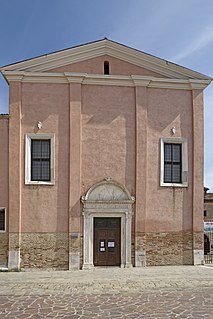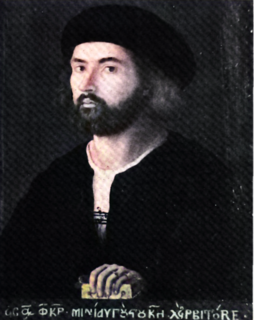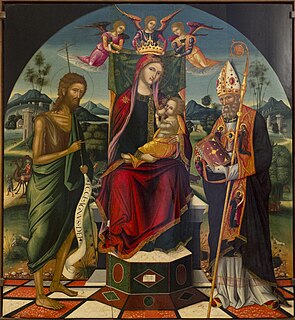Related Research Articles

Giovanni Bellini was an Italian Renaissance painter, probably the best known of the Bellini family of Venetian painters. He was raised in the household of Jacopo Bellini, formerly thought to have been his father, but now that familial generational relationship is questioned. An older brother, Gentile Bellini was more highly regarded than Giovanni during his lifetime, but the reverse is true today. His brother-in-law was Andrea Mantegna.

Gentile Bellini was an Italian painter of the school of Venice. He came from Venice's leading family of painters, and at least in the early part of his career was more highly regarded than his younger brother Giovanni Bellini, the reverse of the case today. From 1474 he was the official portrait artist for the Doges of Venice, and as well as his portraits he painted a number of very large subjects with multitudes of figures, especially for the Scuole Grandi of Venice, wealthy confraternities that were very important in Venetian patrician social life.

Vittore Carpaccio was an Italian painter of the Venetian school, who studied under Gentile Bellini. He is best known for a cycle of nine paintings, The Legend of Saint Ursula. His style was somewhat conservative, showing little influence from the Humanist trends that transformed Italian Renaissance painting during his lifetime. He was influenced by the style of Antonello da Messina and Early Netherlandish art. For this reason, and also because so much of his best work remains in Venice, his art has been rather neglected by comparison with other Venetian contemporaries, such as Giovanni Bellini or Giorgione.

The cultural and artistic events of Italy during the period 1400 to 1499 are collectively referred to as the Quattrocento from the Italian word for the number 400, in turn from millequattrocento, which is Italian for the year 1400. The Quattrocento encompasses the artistic styles of the late Middle Ages, the early Renaissance, and the start of the High Renaissance, generally asserted to begin between 1495 and 1500.

Giovanni di Niccolò Mansueti was an Italian painter.
Events from the year 1514 in art.

The Musée Jacquemart-André is a private museum located at 158 Boulevard Haussmann in the 8th arrondissement of Paris. The museum was created from the private home of Édouard André (1833–1894) and Nélie Jacquemart (1841–1912) to display the art they collected during their lives.
Events from the year 1507 in art.
Events from the year 1505 in art.

Rocco Marconi was an Italian painter of the Renaissance period, active mainly in Venice and Treviso. He was a pupil of the painter Giovanni Bellini along with Vittore Belliniano and Girolamo Santacroce. His first wife died in 1511. He is known to have joined the Venetian painters' guild (fraglia) in 1517, and the Scuola di Sant’Anna in 1526.

Francesco Rizzo da Santacroce, also known as simply Francesco da Santacroce or Francesco di Bernardo de' Vecchi Da Santa Croce was an Italian painter of the Renaissance period, active mainly in Bergamo and Venice.
The decade of the 1490s in art involved some significant events.
The decade of the 1460s in art involved some significant events.

Lazzaro Bastiani was an Italian painter of the Renaissance, active mainly in Venice.

Vittore Belliniano was an Italian painter of the Renaissance period considered to be identical with Bellini Bellini and Vittore di Matteo. He was a native of Venice, active c. year 1525. He painted historical subjects, and several of his pictures were painted for the Scuola di San Marco at Venice and in churches of neighboring towns, like in SS. Vito e Modesto church, in Spinea.

The Church of St Job is a 15th-century Roman Catholic church located overlooking the campo of the same name, known as Sant'Agiopo in Venetian dialect, on the south bank of the Cannaregio canal near Ponte dei Tre Archi in the sestiere of Cannaregio of Venice, northern Italy,

The Portrait of Doge Leonardo Loredan is a painting by the Italian Renaissance master Vittore Carpaccio, a painter of the Venetian School and student of Gentile Bellini. The latter also painted a portrait of Doge Leonardo Loredan. It was most likely painted around 1501/02, at the beginning of Loredan's reign. The painting was restored in 2003 with funding from Mara and Chuck Robinson in honour of Prof. W. R. Rearick, and it is now displayed in the Museo Correr in Venice.

Victor was a Greek painter in Venice active during the middle part of the 16th century. The only surviving painting is his self portrait. He was a painter during the High Renaissance. He drastically escaped the maniera greca. He is comparable to Ioannis Permeniates.

Madonna and Child enthroned with St. John the Baptist and St. Augustine is an oil painting by Greek painter Ioannis Permeniates. He was from Crete living in Venice. He was active during the first part of the 16th century. There are dozens of works attributed to the artist. He is a cross-over artist who painted in both the maniera greca and the Venetian style. Other similar artists were El Greco and Michael Damaskinos. Ioannis Permeniates's work was influenced by Vittore Carpaccio and Giovanni Bellini. His most notable painting is the Madonna and Child enthroned with St. John the Baptist and St. Augustine. Many Italian artists painted the same subject matter. The most famous painting depicting the subjects is the Madonna and Child with St John the Baptist and St Augustine by Petrus Perusinus. The Permeniates is part of the collection Museo Correr in Venice, Italy.
References
- Bryan, Michael (1889). Walter Armstrong; Robert Edmund Graves (eds.). Dictionary of Painters and Engravers, Biographical and Critical. Vol. II L-Z. London: George Bell and Sons. p. 676.